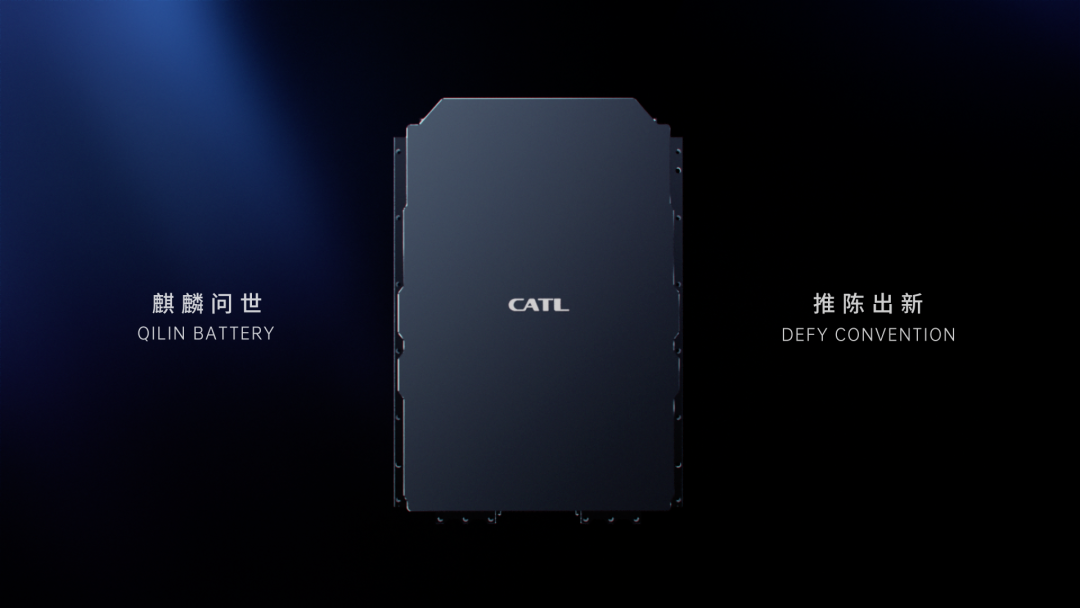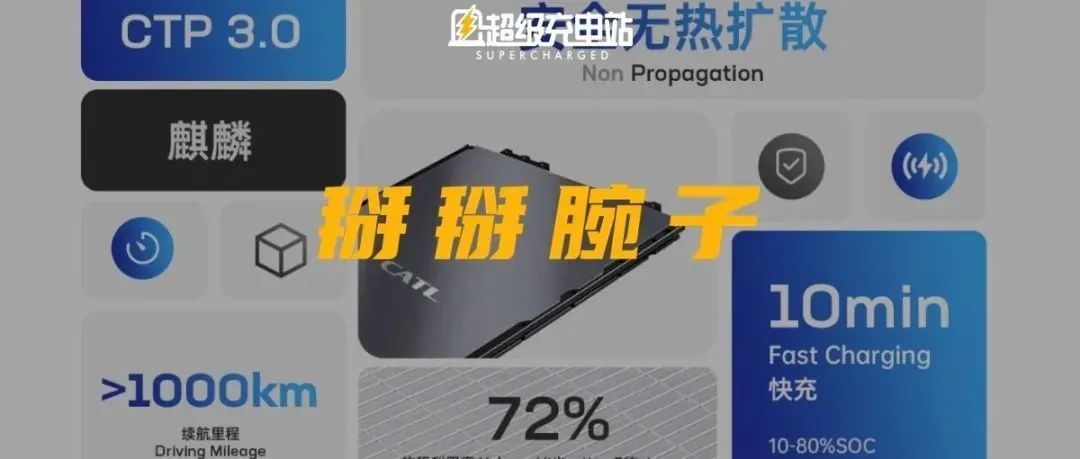Author: French Fries Fish
Three months ago, Wu Kai, the chief scientist of CATL, announced at the 2022 China EV 100 Forum that they were about to release a battery named “Qilin Battery” that would “beat the crap out of” Tesla’s 4680 battery.
Yesterday, CATL officially released the “Qilin Battery”.

If CATL is a torrent in the stock market, then in terms of launching new products, they are undoubtedly a more unreasonable streamflow.
With such a significant new product, CATL used a 3 minute and 57 second short video to finish the entire product launch.
As a “professional spectator of new product launches,” the high-density information density made me inexplicably excited.

Moreover, CATL summed up their vision for Qilin Battery in just eight words –
“Qilin appears, innovation is rejuvenated.”
The New Horizon of CTP
In 2019, CATL pioneered the CTP battery pack (Cell to Pack) globally, first simplifying the three-level structure of “cell-module-battery pack” to the two-level structure of “cell-battery pack.”
Battery volume utilization also broke through the 50% mark, stepping up to 55%, thus opening the “modular-free era” of battery structure.

In these two years, while the industry considers that the CTP technology has hit a bottleneck and range anxiety remains, everyone looks back fondly on the “sweetness” of CTP abandoning the module. Can CTP further simplify the structure?
Therefore, studying and upgrading to the more concise CTC (Cell to Chassis) and CTB (Cell to Body) batteries seems to have become a kind of “political correctness.” New cars seem to be embarrassed to say they are technology-oriented if they lack CTC batteries.
Sometimes, the expression of status in the industry is first reflected in the ability to output counter-current viewpoints, followed by making these viewpoints a reality.
For example, when everyone thought CTP could already be replaced, CATL stood up and said no, CTP can still be saved.
Then CATL quietly pushed CTP technology to 3.0 and even introduced the Qilin Battery.
 Your Highness, may I ask if the rescuing patient in your home uses the ginseng fruit of Wuzhuangguan or the Nine Turns Golden Pill of Taishang Laojun?
Your Highness, may I ask if the rescuing patient in your home uses the ginseng fruit of Wuzhuangguan or the Nine Turns Golden Pill of Taishang Laojun?
When the data of CTP 3.0 Kirin battery is presented in front of us, CTC doesn’t seem that attractive anymore.
- Volume utilization rate exceeds 72%;
- Energy density of ternary battery system is increased to 255Wh/kg;
- Energy density of iron phosphate lithium battery system increases to 160Wh/kg;
- Compared with the same volume of electricity, the 4680 system improves by 13%;
- It is easy to achieve a vehicle with a range of 1000 kilometers;
- 5-minute fast heat-up;
- Supports 4C fast charging, completing 10%-80% in 10 minutes;
- Safe with no thermal diffusion.
So, how did Kirin battery achieve this?
The Three Moves of 3.0
As of today’s development of vehicle power batteries, how to provide electric vehicles with longer range and faster energy replenishment is the core demand, and the subsequent evolution route is actually quite clear, one is material system innovation, and the other is structural innovation.
Looking at the Kirin battery, just like the prefix of Kirin battery, as the CTP 3.0 technology said, in my opinion, Your Highness’s new product is more in line with the second route of structural innovation.

Under the premise that the battery materials remain unchanged, the only way to increase range is to cram more cells into the battery pack.
However, the overall volume of the battery pack is only so large, and so-called structural innovation is nothing more than making more space within the battery pack.
In this regard, the first move made by Kirin battery for making space is called “3 effects in 1”.

Kirin battery cancels the originally independent transverse beam, longitudinal beam, water cooling plate, and heat insulation pad in the battery pack, and integrates them into a “multifunctional elastic interlayer”.

Let’s break down the word “multifunctional elastic interlayer”.
First is “multifunctional”. The structural strength function of the longitudinal and transverse beams, the thermal management function of the water cooling plate, and the thermal insulation function of the heat insulation pad are all incorporated into the new component.
Second is “elastic”. CATL stated that the new component is equipped with nano-bridge connection device, which can breathe freely and stretch together with the cells, and can improve the reliability of the cell’s entire lifecycle.
“Interlayer” refers to the arrangement form, and it will serve as a barrier between the cells.
 The second trump card of the Kirin battery is “4 times cooling capacity”.
The second trump card of the Kirin battery is “4 times cooling capacity”.

The water cooling plate originally set at the bottom of the battery pack is now replaced by a multifunctional elastic interlayer, and the heat exchange contact surface is also switched from the bottom of the battery core to the side of the battery core. According to CATL, this measure increases the heat exchange area by four times.

However, interestingly, Lucid CEO previously pointed out that the heat of the wound core is more concentrated at the ends of the cells, so they did not choose a liquid cooling system design that surrounds the cells.
I do not know whether this heat characteristic mentioned by Lucid also applies to square cells, but according to the data provided by CATL, the Kirin battery’s cell temperature control time is shortened by half, and it does not shorten at the same rate as the increase of the heat exchange area.
However, the enhanced cell temperature control is a certain fact, and better thermal management also brings practical functions such as 5 minutes quick heat start-up and 10 minutes quick charging, both of which require strong thermal management support.

The third trump card of the Kirin battery is “shared space”.

Just removing the water cooling plate at the bottom of the battery pack seems to have failed to satisfy the desire of NIO to “dig space and build a road to enlightenment”. The Kirin battery has been excavated even further.

After theoretical calculation and simulation, the Kirin battery arranges structural protection, high-voltage connection, and thermal run-away exhaust functions in the bottom space. These additional excavations earned Kirin battery an additional 6% energy space.

With the completion of the three trump cards, the volume utilization of the Kirin battery has also reached 72%.
 To see how confident the Prince of Ning is in the Kirin Battery, look at the opponents he threw on the public screen. Even so, Ningde Times felt that it was troublesome to draw a bar chart of the advantages of Kirin Battery compared to 4680.
To see how confident the Prince of Ning is in the Kirin Battery, look at the opponents he threw on the public screen. Even so, Ningde Times felt that it was troublesome to draw a bar chart of the advantages of Kirin Battery compared to 4680.
So they drew a radar chart.

Short Videos Also Have Great Value
After watching the entire 3 minutes and 57 seconds, the expectations given to me by the first three minutes of this Kirin Battery short video, and the hesitation in the last few seconds were equally great. Ningde Times said that Kirin Battery will not start mass production until next year.
However, this hesitation continued for an hour.
An hour after Ningde Times released the Kirin Battery, Li Xiang forwarded their Weibo and commented “see you next year.” I think the meaning behind this is self-evident.

After all, in the ESG report released by IDEAL in April, the company officially confirmed that it will release its first high-voltage electric vehicle model next year. Li Xiang’s Weibo post seems to have confirmed that this new pure electric vehicle model from IDEAL will use Kirin Battery.
“If Li Xiang believes it, why should I hesitate?”
The value of the Kirin Battery is not only in the product, but also remember the stock market boom we mentioned earlier?

When the news of the Kirin Battery came out, yesterday, Ningde Times’ stock price soared, with a gain of 5.91% that day and 4.94% today. Not only did it rise on its own, but it also brought the stock prices of related companies with it. It can only be said that the confidence that Kirin Battery brings to investors is truly strong.

Of course, as an automotive media editor, besides applauding and congratulating the Prince’s rise in stock prices, I am more concerned about when I can drive an electric car with a real cruising range of 1000km.
This article is a translation by ChatGPT of a Chinese report from 42HOW. If you have any questions about it, please email bd@42how.com.
